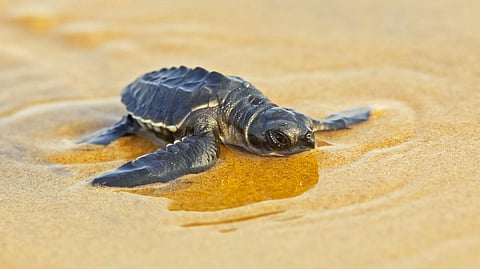Olive Ridley nesting season witnessed laying of more than 3,800 eggs at beaches in Goa
After a delayed start to the turtle nesting season in Goa, a sign of relief for the forest officials as more than 30 Olive Ridley turtles turned up this season at Agonda and Galgibaga Beach to lay eggs. Currently, as many as 3,824 Olive Ridley turtle eggs are protected in 38 nests at protected sites in Goa.
Agonda & Galgibaga beaches turn turtle hub
[rebelmouse-proxy-image https://media.rbl.ms/image?u=%2Fwp-content%2Fuploads%2F2016%2F11%2Fodisha-olive-ridley-tour.jpg&ho=https%3A%2F%2Fwww.toursorissa.com&s=99&h=f9daf16f3aa9c2283e339f1a6ed80623e9d4152234d5ef48d32b59527790d640&size=980x&c=2714606547 photo_credit="" pin_description="" dam="0" site_id=20074994 caption="" photo_credit_src="https://www.toursorissa.com/wp-content/uploads/2016/11/odisha-olive-ridley-tour.jpg" crop_info="%7B%22image%22%3A%20%22https%3A//media.rbl.ms/image%3Fu%3D%252Fwp-content%252Fuploads%252F2016%252F11%252Fodisha-olive-ridley-tour.jpg%26ho%3Dhttps%253A%252F%252Fwww.toursorissa.com%26s%3D99%26h%3Df9daf16f3aa9c2283e339f1a6ed80623e9d4152234d5ef48d32b59527790d640%26size%3D980x%26c%3D2714606547%22%7D" expand=1]
The reserves or sites which were once earmarked as protection or preservation sites due to the decline in flora and fauna numbers have recently been seen to overturn their numbers drastically turning the spotlight to Indian conservation programs and their ability to drastically overturn situations.
According to range officer Anant Velip, the current season of laying eggs began at Agonda on December 31, 2021, with the arrival of the first flipper, which laid as many as 118 eggs before departing. The eggs were then shifted to the hatchery, of which 88 hatchlings have been released into the sea. Thereafter, there were hatchings in another five pits from the nursery, giving a total of 117 eggs, of which 112 hatched a few days ago.
Flippers feeling tourist-y!
[rebelmouse-proxy-image https://media.rbl.ms/image?u=%2Fnews%2Fimage%2F10369968-3x2-940x627.jpg&ho=https%3A%2F%2Fwww.abc.net.au&s=163&h=0eed7ab7dcca3a845525ff94f22aed7b723d2ffa3b11782c42068be3ba250e6f&size=980x&c=3832842201 photo_credit="" pin_description="" dam="0" site_id=20074994 caption="" photo_credit_src="https://www.abc.net.aunewsimage/10369968-3x2-940x627.jpg" crop_info="%7B%22image%22%3A%20%22https%3A//media.rbl.ms/image%3Fu%3D%252Fnews%252Fimage%252F10369968-3x2-940x627.jpg%26ho%3Dhttps%253A%252F%252Fwww.abc.net.au%26s%3D163%26h%3D0eed7ab7dcca3a845525ff94f22aed7b723d2ffa3b11782c42068be3ba250e6f%26size%3D980x%26c%3D3832842201%22%7D" expand=1]
A total of over 11 Olive Ridley turtles have visited Galgibaga beach this year to lay eggs, with the hatchery now housing a total of 1,162 eggs. The last pit at Galgibaga, containing 104 eggs, was protected on March 5, while the last pit at Agonda, with 106 eggs was protected on March 10, added Velip.
Considering the need to protect the endangered Olive Ridley turtles, the government and private NGOs have taken up several conservation programmes under which the forest department has fenced the coastal area at Galgibaga and Agonda beach to ensure appropriate protection of turtle nests.
To get all the latest content, download our mobile application. Available for both iOS & Android devices.

